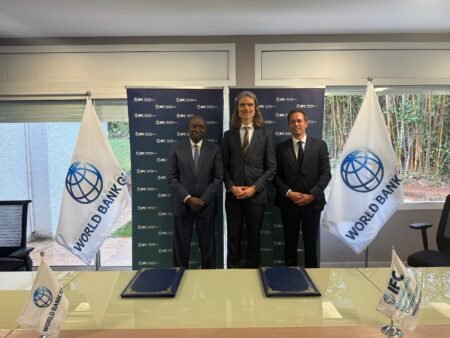University of Cincinnati assistant professor Vikram Kuppa and doctoral student Yan Jin. At the meeting of the American Physical Society, Jin will present on how a blend of conjugated polymers resulted in structural and electronic changes that increased efficiency three-fold, by incorporating pristine graphene into the active layer of the carbon-based materials.
Jin will present on how a blend of conjugated polymers resulted in structural and electronic changes that increased efficiency three-fold, by incorporating pristine graphene into the active layer of the carbon-based materials. The technique resulted in better charge transport, short-circuit current and a more than 200-percent improvement in the efficiency of the devices. “We investigated the morphological changes underlying this effect by using small-angle neutron scattering (SANS) studies of the deuterated-P3HT/F8BT with and without graphene,” says Jin.
The partnership with the Oak Ridge National Laboratory, U.S. Department of Energy, is exploring how to improve the performance of carbon-based synthetic polymers, with the ultimate goal of making them commercially competitive.
Unlike the silicon-or germanium-powered solar cells on the market, polymer substances are less expensive and more malleable. “It would be the sort of cell that you could roll up like a sheet, put it in your backpack and take it with you,” explains Vikram Kuppa, Jin’s advisor and a UC assistant professor of chemical engineering and materials science.
One of the main challenges involving polymer-semiconductors is that they have significantly lower charge transport coefficients than traditional, inorganic semiconductors, which are used in the current solar technology. Although polymer cells are thinner and lighter than inorganic devices, these films also capture a smaller portion of the incoming light wavelengths and are much less efficient in converting light energy to electricity.
“Our approach is significant because we have now shown peak improvement of over 200 percent on a few different systems, essentially a three-fold increase in the efficiency of the cell by addressing the fundamental problem of poor charge transport,” says Kuppa.
Jin led the research conducted at Oak Ridge National Laboratory and at UC’s Organic and Hybrid Photovoltaics Laboratory in the UC College of Engineering and Applied Science (CEAS). “We’re finding that these enhancements resulted from improvements in both charge mobility and morphology,” says Jin. “The morphology is related to the physical structure of the blend in the polymer films and has a strong impact on the performance and the efficiency of the organic photovoltaic (OPV) cells.”
Jin’s future research is continuing on the examination of morphology and its connection to solar cell performance. Part of that research will be conducted on state-of-the-art, Ultra Small Angle X-ray Scattering (USAXS) equipment coming to the College of Engineering and Applied Science at UC, the result of a Major Instrumentation Award to Kuppa from the National Science Foundation. Kuppa says the $400,000 piece of equipment is only the second of its kind in a university in the U.S. and the first such instrumentation with multiple-sources and broad-measurement range.
Co-researchers on the project include Kuppa; Gregory Smith, Structure and Dynamics of Soft Matter group leader, Biology and Soft Matter Division, Oak Ridge National Laboratory, U. S. Department of Energy; James Browning, senior research staff scientist, Chemical and Engineering Materials Division, Neutron Scattering Sciences Directorate, Oak Ridge National Laboratory; Jong Kahk Keum, staff scientist, Center for Nanophase Materials Science, Oak Ridge National Laboratory; and Kunlun Hong, staff scientist, Center for Nanophase Materials Science, Oak Ridge National Laboratory.
###
The American Physical Society is a nonprofit membership organization working to advance and diffuse the knowledge of physics through its research journals, scientific meetings, education, outreach, advocacy and international activities. APS represents over 51,000 members, including physicists in academia, national laboratories and industry in the United States and throughout the world. The March meeting is expected to be attended by nearly 10,000 physicists, scientists and students.
UC’s College of Engineering and Applied Science is a leader in engineering education, research and innovation, and is the world founder of cooperative education.
####
For more information, please click here
Contacts:
Dawn Fuller
dawn.fuller@uc.edu
513-556-1823






